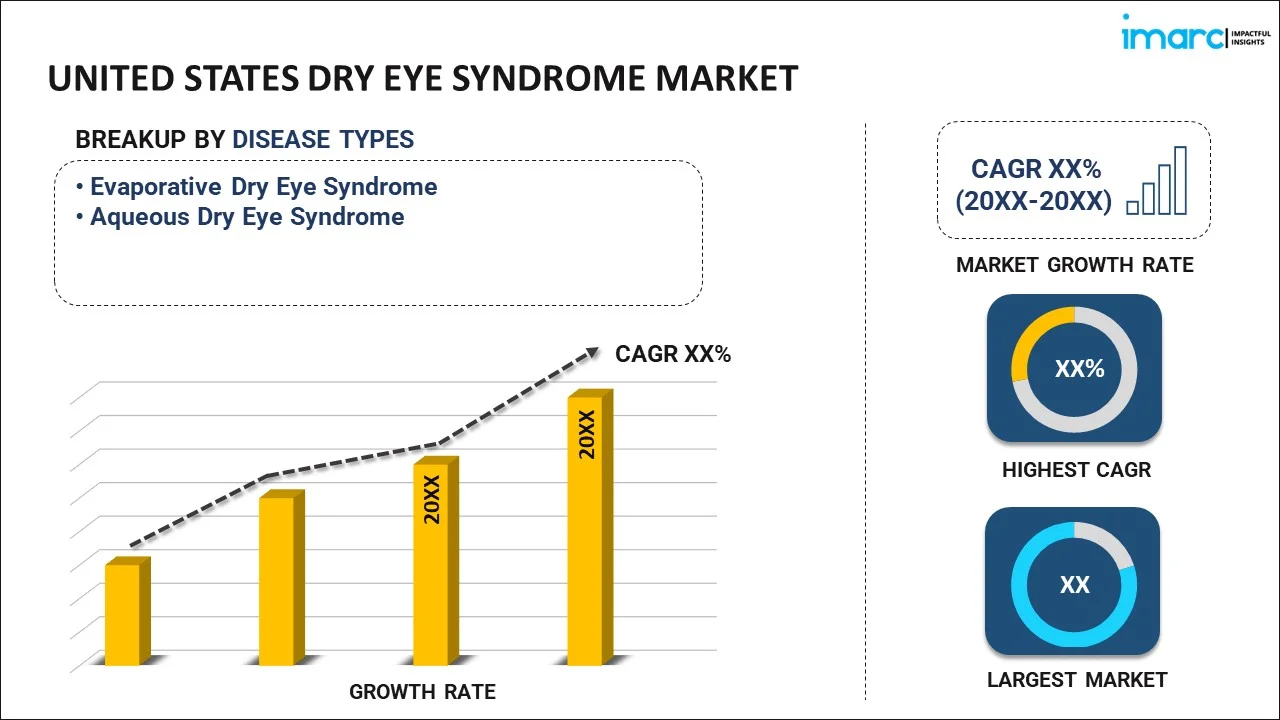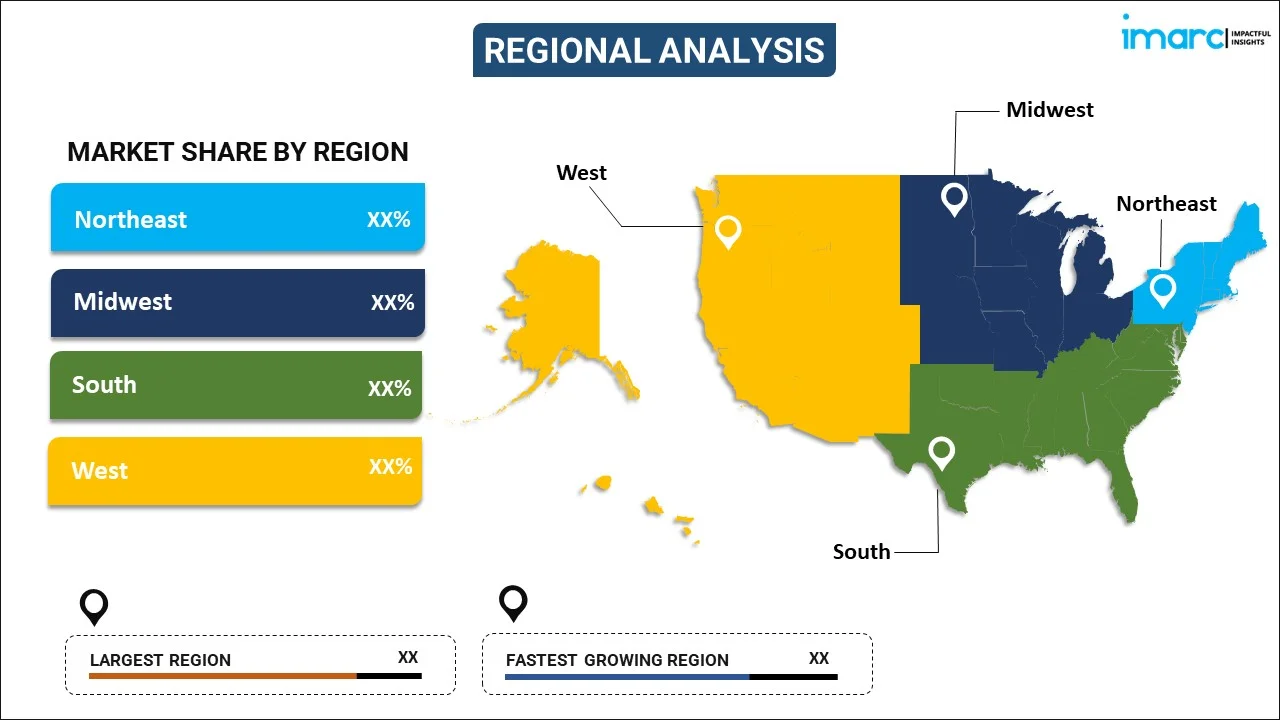
United States Dry Eye Syndrome Market Report by Disease Type (Evaporative Dry Eye Syndrome, Aqueous Dry Eye Syndrome), Drug Type (Anti-inflammatory Drugs, Lubricant Eye Drops, Autologous Serum Eye Drops), Product (Liquid Drops, Gel, Liquid Wipes, Eye Ointment, and Others), Distribution Channel (Hospital Pharmacies, Retail Pharmacies, Online Pharmacies), and Region 2025-2033
Market Overview:
The United States dry eye syndrome market size reached USD 2.7 Billion in 2024. Looking forward, IMARC Group expects the market to reach USD 3.9 Billion by 2033, exhibiting a growth rate (CAGR) of 4.15% during 2025-2033.
|
Report Attribute
|
Key Statistics
|
|---|---|
|
Base Year
|
2024
|
|
Forecast Years
|
2025-2033
|
|
Historical Years
|
2019-2024
|
|
Market Size in 2024
|
USD 2.7 Billion |
|
Market Forecast in 2033
|
USD 3.9 Billion |
| Market Growth Rate 2025-2033 | 4.15% |
United States Dry Eye Syndrome Market Analysis:
- Key Market Drivers: Rise in screen time due to usage of electronic devices, increased contact lens use, and expanding geriatric population susceptible to chronic eye diseases propel United States dry eye syndrome market growth. Moreover, extensive usage of corticosteroid therapy and advancement in healthcare infrastructure fuel market growth in the region.
- Key Market Trends: Product developments such as neurostimulation devices and novel artificial tear formulations are revolutionizing treatment strategies. The growth of the market is fueled by improved diagnostic technologies and customized treatment regimens, opening the door to more efficacious therapeutic interventions and enhanced patient outcomes.
- Competitive Landscape: According to United States dry eye syndrome market analysis, the industry is characterized by heightened competition among pharmaceutical firms with R&D efforts in creating novel treatments. The market share for dry eye syndrome is split between experienced companies targeting anti-inflammatory medication, lubricating eye drops, and novel therapeutic options addressing specific disease processes and patient segments.
- Challenges and Opportunities: Regulatory complexity for approval and prohibitively expensive development challenges emerging treatment launches. There are, however, market research opportunities in personalized medicine, new drug delivery systems, and treating different types and severities of dry eye.
Dry eye syndrome, or keratoconjunctivitis sicca (KCS), is a medical disorder that occurs due to the lack of adequate moisture or lubrication on the surface of the eyes. It is caused due to multiple factors, such as extensive computer usage, menopause, allergies, deficiency of vitamin A, laser surgeries and autoimmune diseases. Dry eye syndrome is characterized by various symptoms, including aching, burning, redness, itchy eyes, pain, discomfort and photophobia. It can be treated by administering artificial tears, surgeries, medications and lacrimal plugs. Dry eye syndrome can be prevented by wearing wraparound sunglasses or other protective eyewear and avoiding excessive smoking.
The growth in the United States dry eye syndrome market can be attributed to the changing lifestyles of the masses and the increasing utilization of electronic gadgets, such as laptops, smartphones and television, leading to excessive and prolonged screen time. In addition, the rising utilization of contact lenses is also increasing the occurrence of dry eye syndrome. The material of the contact lens limits oxygen flow to the cornea and dries up the surface of the eyes. However, various product innovations, such as the development of a neurostimulation device that stimulates the lacrimal gland to temporarily increase natural tear production, are providing a thrust to the market growth. In line with this, the rising geriatric population, which is prone to chronic eye-related diseases, is also contributing to the growth of the market. Dry eye syndrome is associated with various medical conditions, such as rheumatoid arthritis, lupus, scleroderma and diabetes, which can trigger the syndrome in elderly patients. Other factors, including the widespread adoption of corticosteroids drugs for effective treatment, along with significant improvements in the healthcare infrastructure and diagnostic technologies, are creating a positive outlook for the market.
United States Dry Eye Syndrome Market Trends:
Increasing Prevalence and Patient Awareness
The United States is observing an ongoing growth of dry eye syndrome cases as a result of aging populations, widespread use of screens, and environmental causes such as pollution and climate control. Geriatric patients are especially at risk, and the prevalence is much greater in those aged more than 50. Increased patient and practitioner awareness has resulted in increased diagnosis and adoption of treatments, which is directly contributing to United States dry eye syndrome market expansion. Public health campaigns and educational programs have motivated patients to present earlier to seek care, increasing demand for diagnostic and therapeutic interventions. New diagnostic devices, such as tear film osmolarity testing and meibography, increasingly are being implemented in standard care to identify correctly and treat individuals individually. Hence, increased prevalence coupled with enhanced awareness is likely to support growth in clinical intervention and patient engagement, further increasing pharmaceutical and device-based solution opportunities within the market.
Therapeutic Advancements Shaping Market Share
Evolution in treatment modalities is having a strong impact on the United States dry eye syndrome market share. New drug products like anti-inflammatory eye drops, lipid-based drops, and sustained-release ocular inserts are enhancing treatment efficacy and patient compliance. As per the sources, in May 2025, Alcon announced FDA approval of TRYPTYR (acoltremon 0.003%) for Dry Eye Disease, offering rapid tear production for millions of U.S. patients, with commercial launch expected in Q3 2025. Moreover, biologics and combination therapies targeting multiple pathological pathways are evolving for severe or refractory conditions, providing more holistic care. Non-pharmaceutical treatments, such as punctal plugs, thermal pulsation therapy devices, and intense pulsed light therapy, supplement traditional treatment modes, offering comprehensive solutions for patients. These treatment advances increase patient satisfaction, promote longer-term treatment adherence, and fuel market competitiveness. Pharmaceutical and medical device firms are capitalizing on these trends to extend their presence in both inpatient and outpatient markets. With unmet clinical demands being addressed and efficacy as well as convenience enhanced, these developments are transforming treatment regimes and solidifying the market share.
Digital Health and Diagnostic Innovations
Digital health and advanced diagnostics are increasingly driving the United States dry eye syndrome market size. High-precision imaging systems, tear film analyzers, and meibomian gland diagnostic tools are being used by ophthalmologists for correct diagnosis and treatment planning. Artificial intelligence (AI) and machine learning (ML) technologies are augmenting ocular surface image analysis, with early detection, personalized interventions, and enhanced monitoring of treatment response. Telemedicine platforms are providing care to underserved or distant populations, and patient engagement apps enable symptom tracking and adherence monitoring. All these technical advancements automate clinical workflows, minimize diagnostic heterogeneity, and allow evidence-based treatment decisions, improving overall care quality. With healthcare practitioners incorporating increasingly more digital solutions and advanced diagnostics into standard practice, the overall management of dry eye syndrome enhances, driving growth in the market size and solidifying the nation as a top innovator in ophthalmology.
Key Market Segmentation:
IMARC Group provides an analysis of the key trends in each segment of the United States dry eye syndrome market report, along with forecasts at the country and regional levels from 2025-2033. Our report has categorized the market based on disease type, drug type, product and distribution channel.
Breakup by Disease Type:

To get more information on this market, Request Sample
- Evaporative Dry Eye Syndrome
- Aqueous Dry Eye Syndrome
Breakup by Drug Type:
- Anti-inflammatory Drugs
- Lubricant Eye Drops
- Autologous Serum Eye Drops
Breakup by Product:
- Liquid Drops
- Gel
- Liquid Wipes
- Eye Ointment
- Others
Breakup by Distribution Channel:
- Hospital Pharmacies
- Retail Pharmacies
- Online Pharmacies
Breakup by Region:

- Northeast
- Midwest
- South
- West
Competitive Landscape:
The competitive landscape of the industry has also been examined along with the profiles of the key players.
United States Dry Eye Syndrome Market News:
- In May 2025, Grifols received FDA clearance to begin a Phase 2 trial of its immunoglobulin eye drops, GRF312 Ophthalmic Solution, as a potential new treatment for dry eye disease in the United States. The study will evaluate safety, tolerability, and effectiveness, building on positive results from earlier research.
- In January 2024, Harrow announced the U.S. availability of VEVYE® (cyclosporine ophthalmic solution) 0.1%, the first cyclosporine-based treatment addressing both signs and symptoms of dry eye disease, offering rapid relief from Day 15 and sustained improvement over 56 weeks.
- In June 2024, Nordic Pharma launched LACRIFILL Canalicular Gel in the United States, an FDA-cleared dry eye therapy that temporarily blocks tear drainage. The in-office procedure customizes tear retention for each patient, enhancing natural eye lubrication and offering a novel approach to managing dry eye symptoms.
Report Coverage:
| Report Features | Details |
|---|---|
| Base Year of the Analysis | 2024 |
| Historical Period | 2019-2024 |
| Forecast Period | 2025-2033 |
| Units | Billion USD |
| Segment Coverage | Disease Type, Drug Type, Product, Distribution Channel, Region |
| Region Covered | Northeast, Midwest, South, West |
| Customization Scope | 10% Free Customization |
| Post-Sale Analyst Support | 10-12 Weeks |
| Delivery Format | PDF and Excel through Email (We can also provide the editable version of the report in PPT/Word format on special request) |
Key Questions Answered in This Report
The dry eye syndrome market in the United States was valued at USD 2.7 Billion in 2024.
The United States dry eye syndrome market is projected to exhibit a CAGR of 4.15% during 2025-2033, reaching a value of USD 3.9 Billion by 2033.
The market is driven by increasing screen time from electronic devices, rising contact lens usage, growing geriatric population prone to chronic eye conditions, widespread adoption of corticosteroid treatments, product innovations including neurostimulation devices, and improved healthcare infrastructure supporting better diagnostic and treatment capabilities.
Need more help?
- Speak to our experienced analysts for insights on the current market scenarios.
- Include additional segments and countries to customize the report as per your requirement.
- Gain an unparalleled competitive advantage in your domain by understanding how to utilize the report and positively impacting your operations and revenue.
- For further assistance, please connect with our analysts.
 Request Customization
Request Customization
 Speak to an Analyst
Speak to an Analyst
 Request Brochure
Request Brochure
 Inquire Before Buying
Inquire Before Buying




.webp)




.webp)












